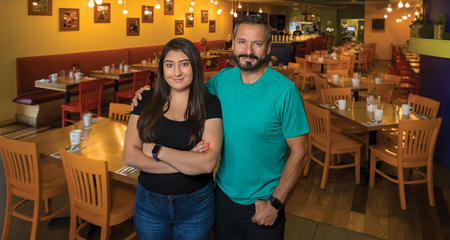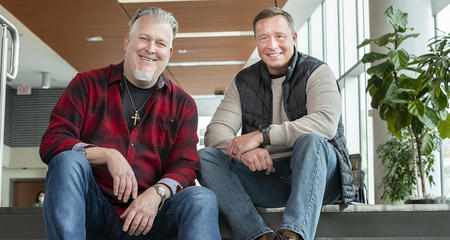It is uncommon for patients who are hospitalized to enjoy physical, occupational and speech therapy. Therapy is hard work, especially after a traumatic brain or spinal injury. But add a bouncing golden retriever with a wagging tail and a willingness to play fetch, and the experience and results improve dramatically. There is strong evidence showing animal therapy programs in hospitals provide both physical and emotional support to patients. Hospitals including Froedtert & the Medical College of Wisconsin Froedtert Hospital are using animal assisted therapy (ATT) to bring happiness and physical healing to patients.
“The staff and patients look forward to the days when the therapy dogs are on site as a treatment option on the rehabilitation unit,” said Lynn Roeber, who works as a nurse manager in rehabilitation for patients with spinal cord injuries or neurological conditions at Froedtert Hospital. “The decreased anxiety and improved confidence is apparent following an animal assisted therapy session. We have observed the patients to be more responsive during and following treatment.”
Medical research since the 1980s has supported the idea that animal-human interaction can have physical benefits, including increasing the life expectancy for heart attack patients. A study conducted by Connor and Miller on ATT in medical settings shows that animal interaction not only calmed patients, but also helped increase patient cognition, range of motion, strength and balance. New research shows a potential increase in people’s hormone oxytocin levels, a hormone that is linked to happiness.

Laurel Shipton, who was injured in a car crash in February 2016, pictured here with Cooper, a therapy dog.
An extra boost of happiness was just what Laurel Shipton, 56, of Unity, Wis., needed after a drunk driver hit the car she was riding in with her family on February 2016. She was just one block away from her home. She sustained a spinal cord injury and was partially paralyzed. Laurel was hospitalized at Froedtert Hospital for six weeks and underwent multiple surgeries followed by daily physical and occupational therapy to help her begin to regain fine and gross motor skills.
Her care team included one member who she described as especially fun: a golden retriever named Cooper. Therapists, including occupational therapist Angie Marszalkowski, facilitated exercises, and had Laurel grasp a brush to strengthen her fingers and comb Cooper’s fur, hold small treats between her fingertips and put them into cups for Cooper to find, and throw a ball in a game of fetch. While Laurel brushed Cooper, he was actually helping her improve her balance by her leaning forward and controlling her movements so she didn’t fall.
“It’s a workout,” Laurel said, smiling, while Cooper licked her hand. “I have three dogs at home, so this is good for me. It’s fun to have him respond to what I’m doing. It’s positive feedback.”
“The use of therapy animals in a safe and structured setting has been shown to help facilitate the relationship between care giver and patient and help patients view their hospital experience in a more positive way,” said Sharon Feldmann, manager, SCIC/Neuro Rehab.
Froedtert Hospital’s Animal Assisted Therapy Program began in May 2014 on the inpatient floor Sharon manages, a 31-bed unit for patients in recovery. The program is provided in partnership with the ATT service Health Heelers and with support from the Froedtert Hospital Foundation. Under the guidance of owner Laura Hey, a former occupational therapist herself, the dogs and their handlers work with therapists to incorporate physical, occupational and speech therapy into their time. Hey said some of the documented benefits of therapy dogs in hospital settings include decreasing anxiety and heart stress, increasing mobility and activity and improving performance toward therapy goals.
“Animal assisted therapy provides an outward focus, decreasing attention to pain, illness and impairment. Patients show greater participation and reach rehabilitation milestones more readily, all while enjoying their time with the therapy dog,” Hey said. Therapy dogs also visit patients’ bedsides some evenings to offer comfort and support during their stay.
At the end of her session, Laurel gets one last game of fetch with Cooper. Cooper waits, tense and expectant, as Laurel brings her arms back to throw the ball. She misses once, and the ball careens sideways. But unlike many patients in a typical therapy session, she doesn’t hesitate to pick it up quickly to try again. Cooper, she knows, is waiting.
For more information or questions about the Animal Assisted Therapy program please contact Sharon Feldmann.


